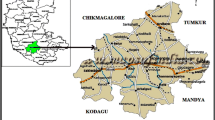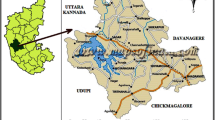Abstract
In the present study, 80 samples of water from hand pumps and 63 samples of tap water were collected from the Bageshwar district of Uttarakhand, state of India. The radon activity concentration is varied from 1 to 21 Bq/L with a mean value of 7 ± 4 Bq/L in tap water samples while for handpump water samples radon activity concentration is varied from 3 to 42 Bq/L with a mean value of 20 ± 9 Bq/L. The average radon level in drinking water in the study region was higher than the radon level in water of Haridwar and Karanprayag districts of Uttarakhand and lower than the radon level in the drinking water of Dehradun, New Tehri, Pauri Garhwal and Pithoragarh districts of Uttarakhand. The mathematical estimation of radiological dose due to inhalation and ingestion of radon in water was calculated and discussed in detail in this study. Age dependent effective dose is estimated to compare the radiological effect on different age-groups. The trend of the mean values of radon ingestion dose in distinct age-groups is likely to be as infants > adults > children.







Similar content being viewed by others
References
Cosma C, Moldovan M, Dicu T, Kovacs T (2008) Radon in water from Transylvania (Romania). Radiat Meas 43:1423–1428. https://doi.org/10.1016/J.RADMEAS.2008.05.001
Bajwa BS, Kumar S, Singh S et al (2017) Uranium and other heavy toxic elements distribution in the drinking water samples of SW-Punjab, India. J Radiat Res Appl Sci 10:13–19. https://doi.org/10.1016/j.jrras.2015.01.002
Ramola RC, Choubey VM, Prasad Y et al (2006) Variation in radon concentration and terrestrial gamma radiation dose rates in relation to the lithology in southern part of Kumaon Himalaya, India. Radiat Meas 41:714–720
Appleton JD (2013) Radon in air and water. Essentials of medical geology. Springer, pp 239–277
Ramola RC, Choubey VM, Negi MS et al (2008) Radon occurrence in soil–gas and groundwater around an active landslide. Radiat Meas 43:98–101. https://doi.org/10.1016/J.RADMEAS.2007.05.054
El-Araby EH, Soliman HA, Abo-Elmagd M (2019) Measurement of radon levels in water and the associated health hazards in Jazan, Saudi Arabia. J Radiat Res Appl Sci 12:31–36. https://doi.org/10.1080/16878507.2019.1594134
Jalili-Majareshin A, Behtash A, Rezaei-Ochbelagh D (2012) Radon concentration in hot springs of the touristic city of Sarein and methods to reduce radon in water. Radiat Phys Chem 81:749–757
Todorovic N, Nikolov J, Forkapic S et al (2012) Public exposure to radon in drinking water in Serbia. Appl Radiat Isot 70:543–549
Jobbágy V, Stroh H, Marissens G, Hult M (2019) Comprehensive study on the technical aspects of sampling, transporting and measuring radon-in-water. J Environ Radioact 197:30–38
Ruosteenoja E (1991) Indoor radon and risk of lung cancer: an epidemiological study in Finland. Finnish Centre for Radiation and Nuclear Safety (STUK)
Lubin JH, Boice JD Jr (1997) Lung cancer risk from residential radon: meta-analysis of eight epidemiologic studies. J Natl Cancer Inst 89:49–57
Choubey VM, Bartarya SK, Ramola RC (2006) Geological Controls on Radon in Soil and water of Pithoragarh region, Kumaun Himalaya, India. In: Radon investigations in the Czech Republic XI and the 8th international workshop on the Geological Aspects of Radon Risk Mapping.–72–78, Czech Geol. Surv. Prague
Ajay K, Manpreet K, Rohit M et al (2016) Quantification and assessment of health risk due to ingestion of uranium in groundwater of Jammu district, Jammu & Kashmir, India. J Radioanal Nucl Chem 310:793–804
Ramola RC, Choubey VM, Prasad G et al (2011) Radionuclide analysis in the soil of Kumaun Himalaya, India, using gamma ray spectrometry.Curr Sci906–914
Semwal P, Agarwal TK, Singh K et al (2019) Indoor inhalation dose assessment for thoron-rich regions of Indian Himalayan belt. Environ Sci Pollut Res 26:4855–4866. https://doi.org/10.1007/s11356-018-3891-0
Sahoo BK, Mayya YS, Sapra BK et al (2010) Radon exhalation studies in an Indian uranium tailings pile. Radiat Meas 45:237–241
Ravikumar P, Somashekar RK (2014) Determination of the radiation dose due to radon ingestion and inhalation. Int J Environ Sci Technol 11:493–508
Field RW, Withers BL (2012) Occupational and environmental causes of lung cancer. Clin Chest Med 33:681–703
Missimer TM, Teaf C, Maliva RG et al (2019) Natural radiation in the rocks, soils, and groundwater of Southern Florida with a discussion on potential health impacts. Int J Environ Res Public Health 16:1793
Kumar A, Singh P, Semwal P et al (2021) Study of primordial radionuclides and radon/thoron exhalation rates in Bageshwar region of Kumaun Himalaya, India.J Radioanal Nucl Chem1–7
Semwal P, Singh K, Agarwal TK et al (2018) Measurement of 222Rn and 220Rn exhalation rate from soil samples of Kumaun Hills, India. Acta Geophys 66:1203–1211. https://doi.org/10.1007/s11600-018-0124-3
Kumar A, Singh P, Agarwal T et al (2020) Statistical inferences from measured data on concentrations of naturally occurring radon, thoron, and decay products in Kumaun Himalayan belt. Environ Sci Pollut Res 27:40229–40243. https://doi.org/10.1007/s11356-020-09920-9
Kumar A, Arora T, Singh P et al (2021) Quantification of radiological dose and chemical toxicity due to radon and uranium in drinking water in Bageshwar region of Indian Himalaya. Groundw Sustain Dev 12:100491
Valdiya KS (1980) Geology of kumaun lesser Himalaya. Wadia Institute of Himalayan Geology
Seth R, Mohan M, Singh P et al (2015) Assessment of seasonal variations in surface water quality of Bageshwar District, Uttarakhand, India for drinking and irrigation purposes. Proc Natl Acad Sci India Sect A Phys Sci 85:283–293
USGS USDI (2017) Earth Explorer. 2000
Gaware JJ, Sahoo BK, Sapra BK, Mayya YS (2011) Indigenous development and networking of online radon monitors in the underground uranium mine. Radiat Prot Environ 34:37
Kumar M, Kaushal A, Sahoo BK et al (2019) Measurement of uranium and radon concentration in drinking water samples and assessment of ingestion dose to local population in Jalandhar district of Punjab, India. Indoor Built Environ 28:611–618
Prasad Y, Prasad G, Gusain GS et al (2009) Seasonal variation on radon emission from soil and water. Indian J Phys 83:1001–1010
Sowby FD (1981) Annals of the ICRP. Ann ICRP 6:1. https://doi.org/10.1016/0146-6453(81)90127-5
Radiation UNSC on the E of A (2000) United Nations Scientific Committee on the Effects of Atomic Radiation 2000 report to the general assembly with scientific annexes. New York United Nations
Brudecki K, Li WB, Meisenberg O et al (2014) Age-dependent inhalation doses to members of the public from indoor short-lived radon progeny. Radiat Environ Biophys 53:535–549
Kaur M, Kumar A, Mehra R, Mishra R (2019) Age-dependent ingestion and inhalation doses due to intake of uranium and radon in water samples of Shiwalik Himalayas of Jammu and Kashmir, India. Environ Monit Assess 191:1–17
Goswami PK, Pant CC (2008) Morphotectonic evolution of the Binau-Ramganga-Naurar transverse valley, southern Kumaun Lesser Himalaya. Curr Sci 94:1640–1645
Bourai AA, Aswal S, Dangwal A et al (2013) Measurements of radon flux and soil-gas radon concentration along the Main Central Thrust, Garhwal Himalaya, using SRM and RAD7 detectors. Acta Geophys 61:950–957. https://doi.org/10.2478/s11600-013-0132-2
Sharma S, Kumar A, Mehra R, Kaur R, INGESTION AND INHALATION DOSES DUE TO INTAKE OF RADON IN DRINKING WATER SAMPLES OF AMRITSAR PROVINCE, PUNJAB, INDIA (2019) Radiat Prot Dosimetry 187:230–242. https://doi.org/10.1093/rpd/ncz157
Sayato Y (1989) WHO Guidelines for Drinking-Water Quality. Eisei kagaku 35:307–312. https://doi.org/10.1248/jhs1956.35.307
Bem H, Plota U, Staniszewska M et al (2014) Radon (222 Rn) in underground drinking water supplies of the Southern Greater Poland Region. J Radioanal Nucl Chem 299:1307–1312
Garg P, Krishan G (2017) Radon Concentration Measurement in Groundwater of Roorkee, Uttarakhand, India. Curr World Environ 12:396
Garg PK, Krishan G, Kumar S (2015) Radon concentration in groundwater of Haridwar, Uttarakhand, India. J Earth Sci Eng 8:1–4
Prasad M, Kumar GA, Sahoo BK, Ramola RC (2018) A comprehensive study of radon levels and associated radiation doses in Himalayan groundwater. Acta Geophys 66:1223–1231
Prasad M, Kumar GA, Sahoo SK, Ramola RC (2019) Health risks associated with the exposure to uranium and heavy metals through potable groundwater in Uttarakhand state of India. J Radioanal Nucl Chem 319:13–21
Singh P, Nautiyal OP, Joshi M et al (2021) Assessment of physicochemical and radon-attributable radiological parameters of drinking water samples of Pithoragarh district, Uttarakhand. J Radioanal Nucl Chem. https://doi.org/10.1007/s10967-021-08056-5
Herschy RW (2012) Water quality for drinking: WHO guidelines. Encycl Earth Sci Ser 876–883. https://doi.org/10.1007/978-1-4020-4410-6_184
Author information
Authors and Affiliations
Corresponding author
Additional information
Publisher’s Note
Springer Nature remains neutral with regard to jurisdictional claims in published maps and institutional affiliations.
Rights and permissions
About this article
Cite this article
Kumar, A., Singh, D., Semwal, P. et al. Comparative study of two different water sources in the aspect of radiological exposure to the local population of Bageshwar, India. J Radioanal Nucl Chem 331, 1941–1949 (2022). https://doi.org/10.1007/s10967-022-08238-9
Received:
Accepted:
Published:
Issue Date:
DOI: https://doi.org/10.1007/s10967-022-08238-9




